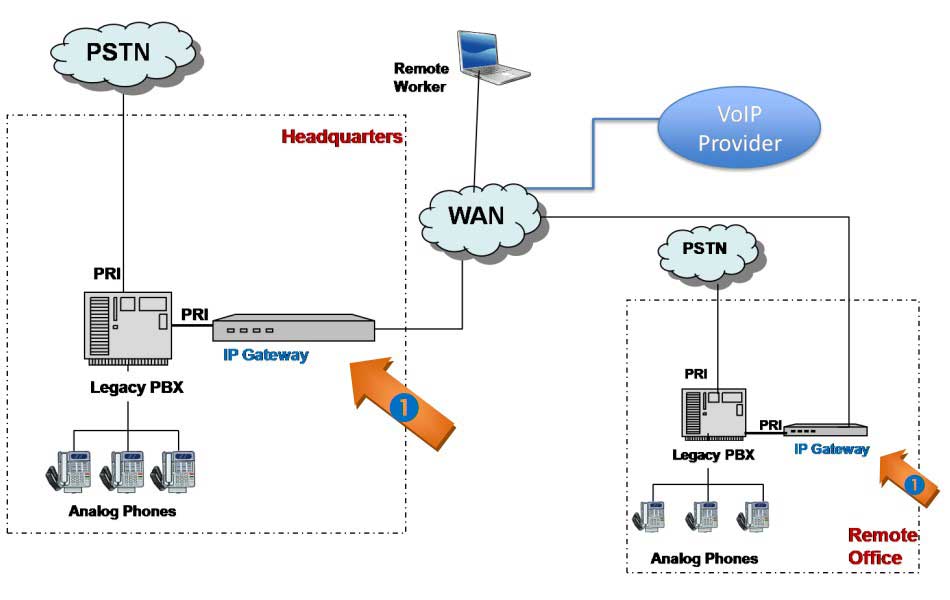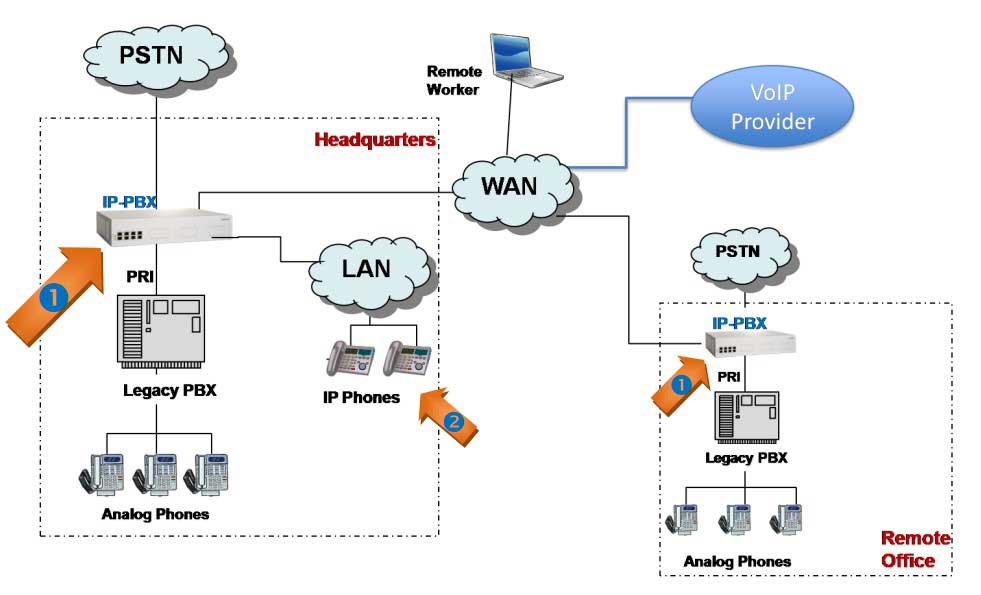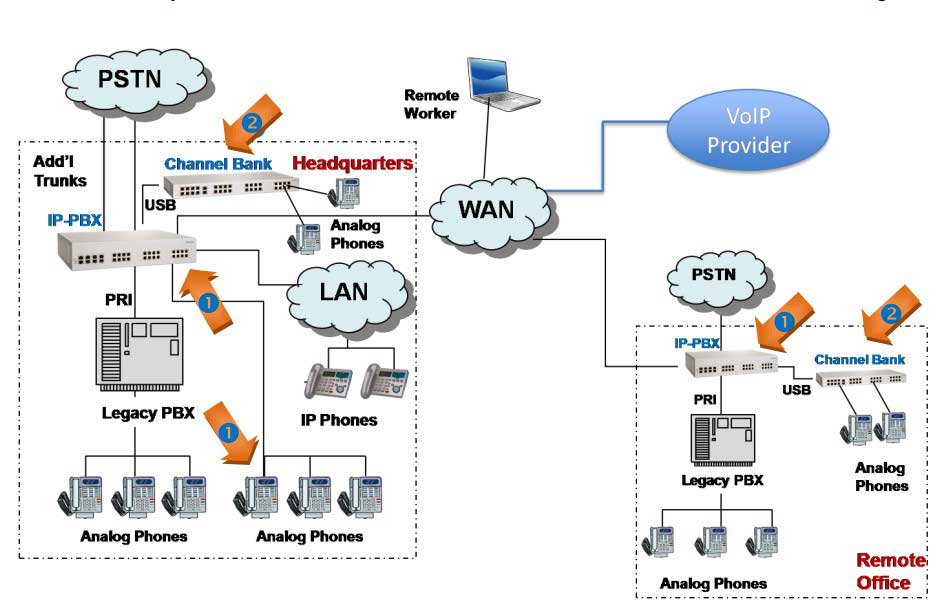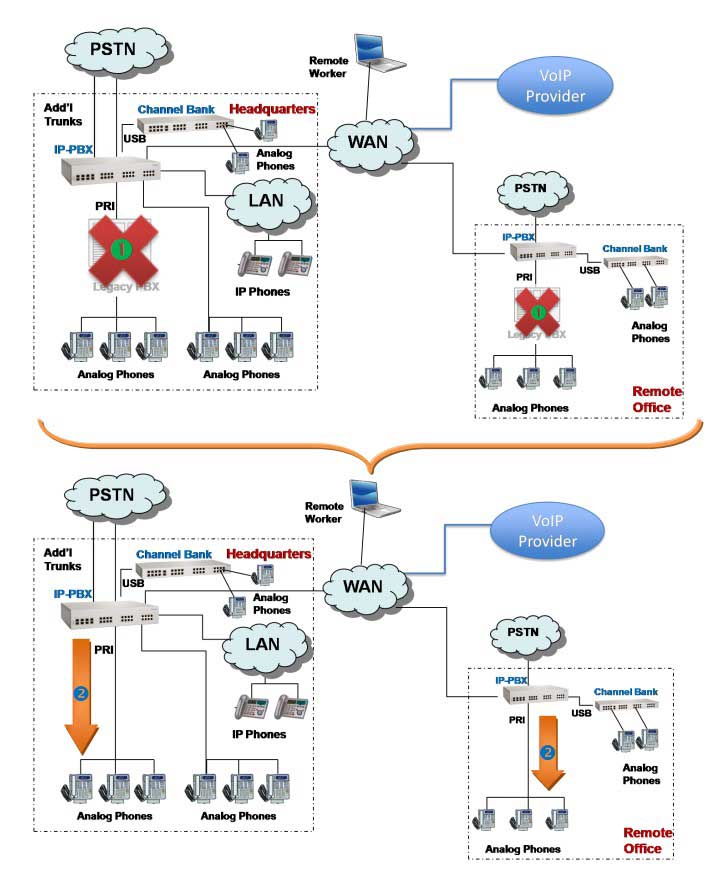IP conversion for legacy PBX installations – a phased approach
Overview
Many organizations are reluctant to replace their existing PBX because switching to VoIP – an IP-PBX can be an expensive endeavor. The gradual approach described below provides an excellent conversion strategy with a controlled budget.
Possible Reasons for Wanting to Move to an IP-PBX
There are many reasons why companies would choose to move from a traditional PBX to VoIP – an IP-PBX. Following is a partial list of common reasons:
- Lowering communication costs
- Support for remote extension(s)
- Remote/branch IP-PBX networking capabilities
- Adding local SIP phone sets
- Inclusion of soft phones in the network
- Improved availability of workforce
- Road warriors
- Tele-workers
Obstacles to Moving to VoIP technology – an IP-PBX
There are a few departments in the company that may object to implementing an IP-PBX. For example, the Finance Department may trot out the well known “If it ain’t broke, don’t fix it!” adage. The CFO may think of the equipment costs and leverage them against what s/he sees as lost assets: the legacy PBX and analog phone sets that will become redundant. The Operations Department may be wary of new VoIP technology, and worry about having to deal with infrastructure hassle and system downtime. Middle Management may be concerned that a new system will waste employees’ time as a result of their learning curve on the new system. They may also feel that employees, as creatures of habit, may resist having to use new communication methods.

By adding an IP Gateway via a PRI connection to the legacy PBX in both the headquarters and remote offices (1), the enterprise can benefit from incoming/outgoing VoIP calls.
Drawbacks of the IP Gateway Approach
Unfortunately, there are many disadvantages inherent in this type of solution. Configuring and connecting each gateway involve applying IP settings for each device and replicating this information in PBX settings, a tedious and error-prone activity. In addition, the IP Gateway solves the single issue of IP connectivity, which is a temporary solution since the evolution to an IP-PBX is inevitable. This will make the IP Gateway redundant over time. Also, due to its “closed box” nature, the IP Gateway is not flexible and not upgradable. It is imperative to install identical IP Gateways in each location to avoid compatibility issues. Last but not least, since the IP Gateway will never replace the legacy PBX, the maintenance fees and utilities costs for that existing equipment are ongoing.
Phased Solution to Achieve Best Results when Transitioning to VoIP Technology – IP-PBX Solution
There is a better way to gain the benefits of VoIP in the enterprise. It can be done using a transitional approach that serves to provide all the desired features of VoIP while adhering to a controlled budget and roll-out that will satisfy all departments in the enterprise. The three-phase approach described below includes, from the very first stage, all the benefits of the IP Gateway, plus dozens of IP-PBX features, such as:
- IVR system
- Voice mail, Voice mail to e-mail
- Conference bridge
- IP trunks (low cost telephony providers)
- Additional extensions (analog, IP)
- Fax-to-mail …
and best of all, it’s “future-proof”.
Overview of the Three Phases in the Transitional Approach
- Phase I: Add an IP-PBX and IP Phones to the network to create “three-legged” telephony connectivity: PBX, PSTN, and IP/LAN/WAN.
- Phase II: Add more ports and trunks to the existing network as needed.
- Phase III: Disconnect the legacy PBX altogether and rely solely on the IP-PBX for all telephony needs.
Phase I: Adding the IP-PBX
In a risk-free move, an IP-PBX is added to the existing network, as illustrated in the diagram below:

Phase I of the transitional approach: an IP-PBX is placed between the legacy PBX and the PSTN (1), and SIP phones are added (2).
- remote offices
- tele-workers
- telephony providers (SIP trunk)
- all IP-PBX features
Phase II: Natural Expansion
When more analog phones are needed, the customer can simply add FXS modules to the IP-PBX chassis. If the internal capacity of the IP-PBX is reached, it is possible to attach channel banks with the required modules to the IP-PBX via its USB 2 port. If more FXO ports are needed, the customer can use this same method to add more FXO trunks. If more PRI ports are needed, additional PRI licenses can be purchased to activate additional ports in the existing IP-PBX PRI module. This phase is illustrated in the diagram below:

Additional telephony ports are added to (or activated in, for PRI) the IP-PBX chassis (1) to accommodate natural expansion of the telephony network. A USB-connected channel bank (2) can be used to further expand the number of extensions and/or trunks supported.
Phase III: Elimination of the Legacy PBX
Eventually, when the customer is ready to replace his old PBX completely with an IP-PBX, the existing IPPBX can take over all the traditional PBX functionality, as well as provide additional features supported only in IP environments. The customer will be able to connect the existing infrastructure (analog phones, analog/digital lines) using additional channel banks, or by transitioning to IP phones and IP trunks. In many cases the ROI period for this additional hardware will be very short since the customer will no longer have to pay maintenance/service for the legacy PBX. This stage is illustrated in the diagram below:

In Phase III, the legacy PBX is no longer required (1), as the IP-PBX takes over responsibility for all telephony communication in the enterprise (2).
Summary: A Comparison of the Two Approaches
Let’s review the two methods for incorporating VoIP into the enterprise:
IP Gateway Approach
- Solves single issue: IP connectivity (temporary)
- Closed system = not flexible/not upgradable
- Limited solution = becomes redundant when IP-PBX is implemented
- Different products for HQ and remote offices
- Will never replace the PBX, maintenance fees and utilities costs are ongoing
Transitional Approach
- Solves multiple issues: full IP-PBX functionality
- Open system = continually being enhanced
- Evolving solution = provides leading-edge telephony when customer is ready
- Same products for HQ and remote offices
- Replaces the PBX at any time, eliminating maintenance fees and utilities costs
“In this first stage of implementation our company is greatly satisfied with the behavior of the new telephony system, Xorcom’s IP PBXs and the great number of extensions installed.”
